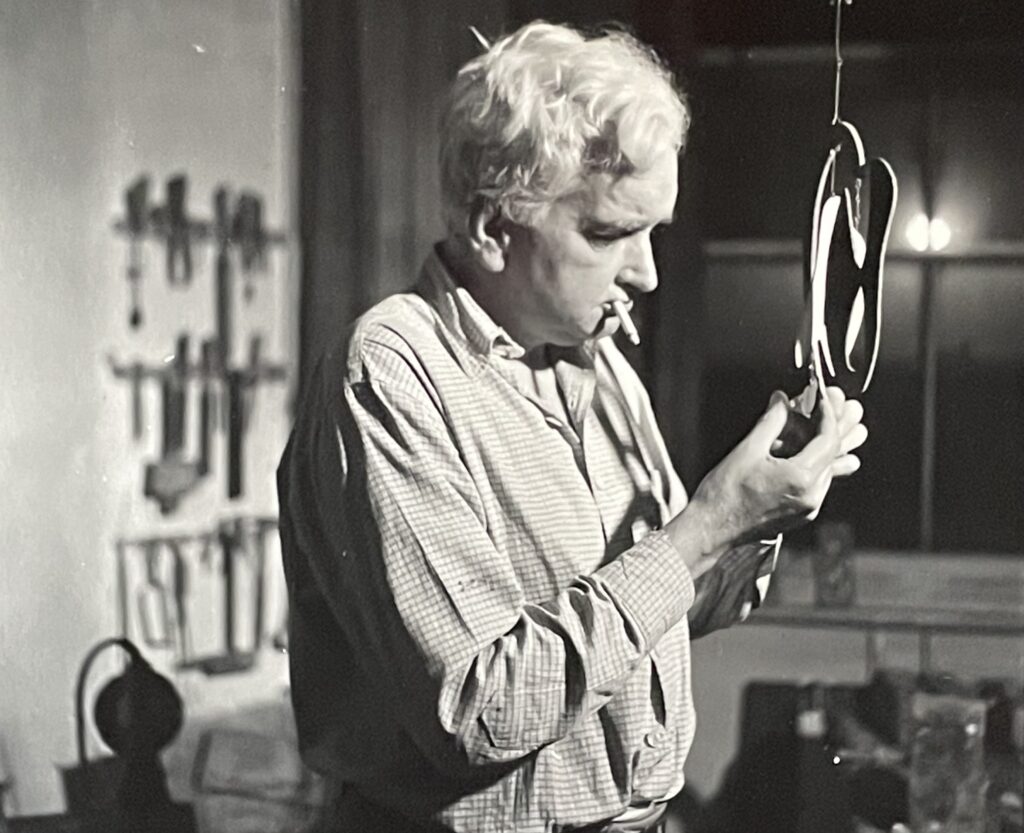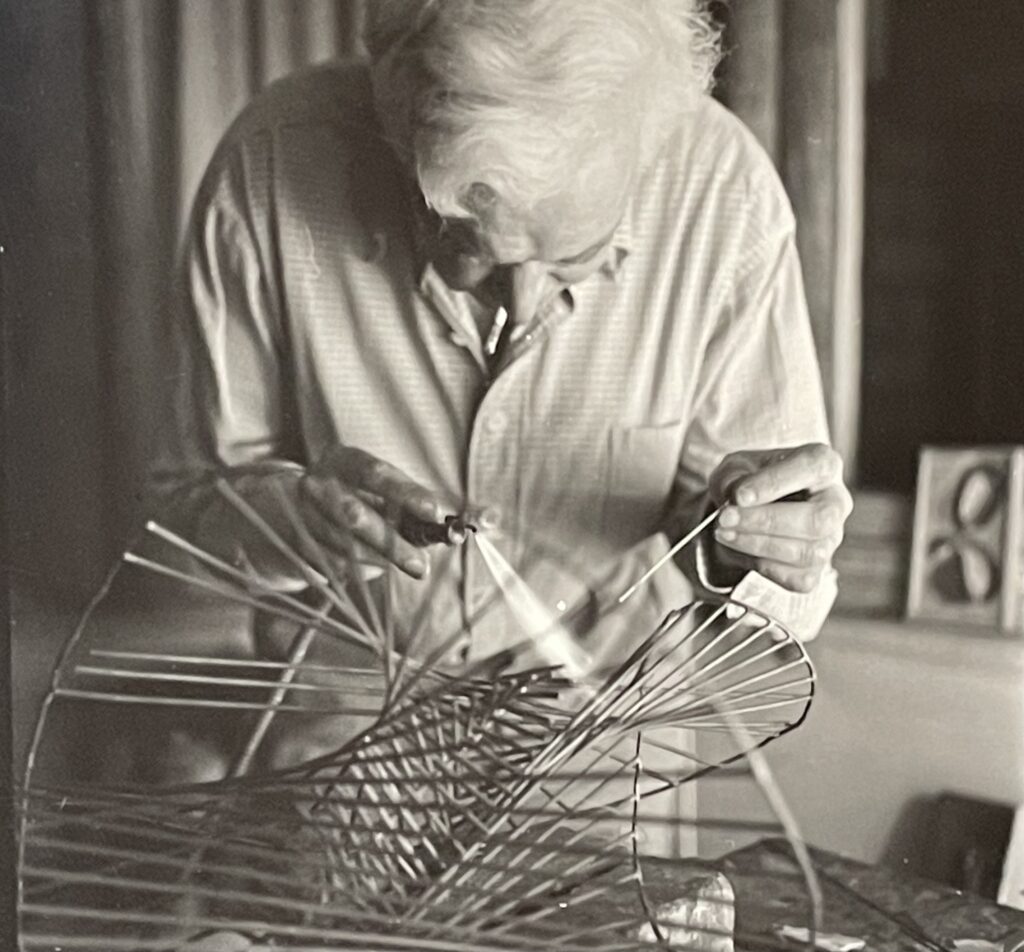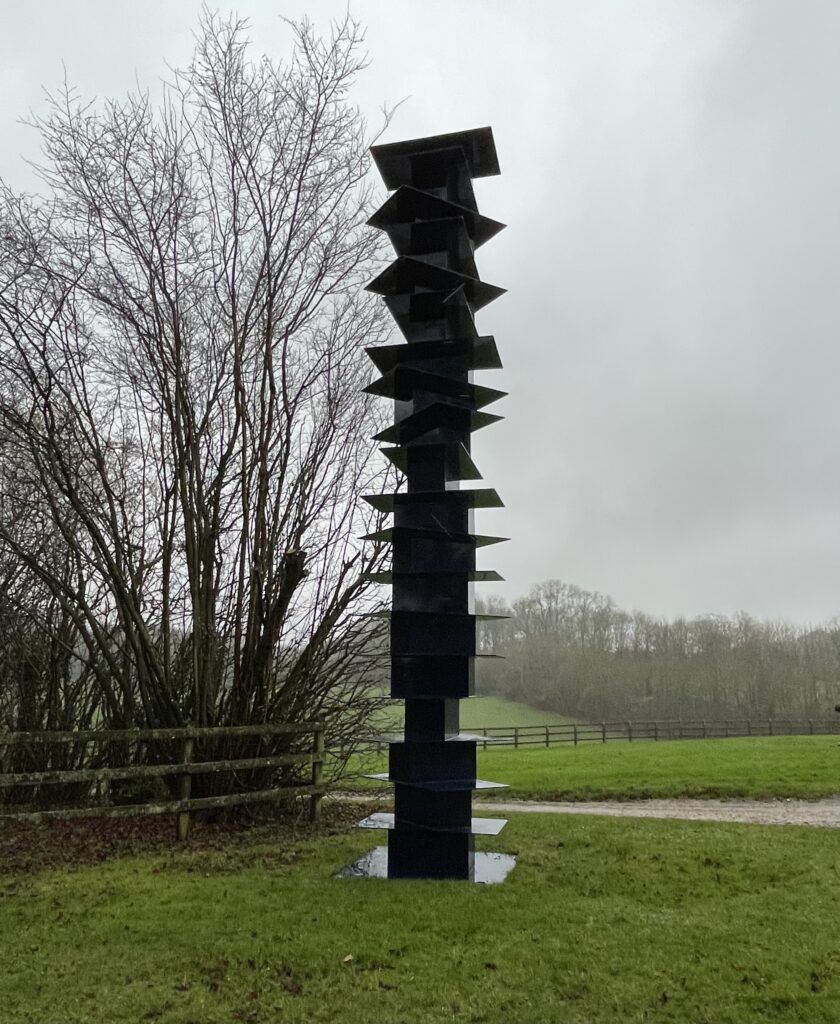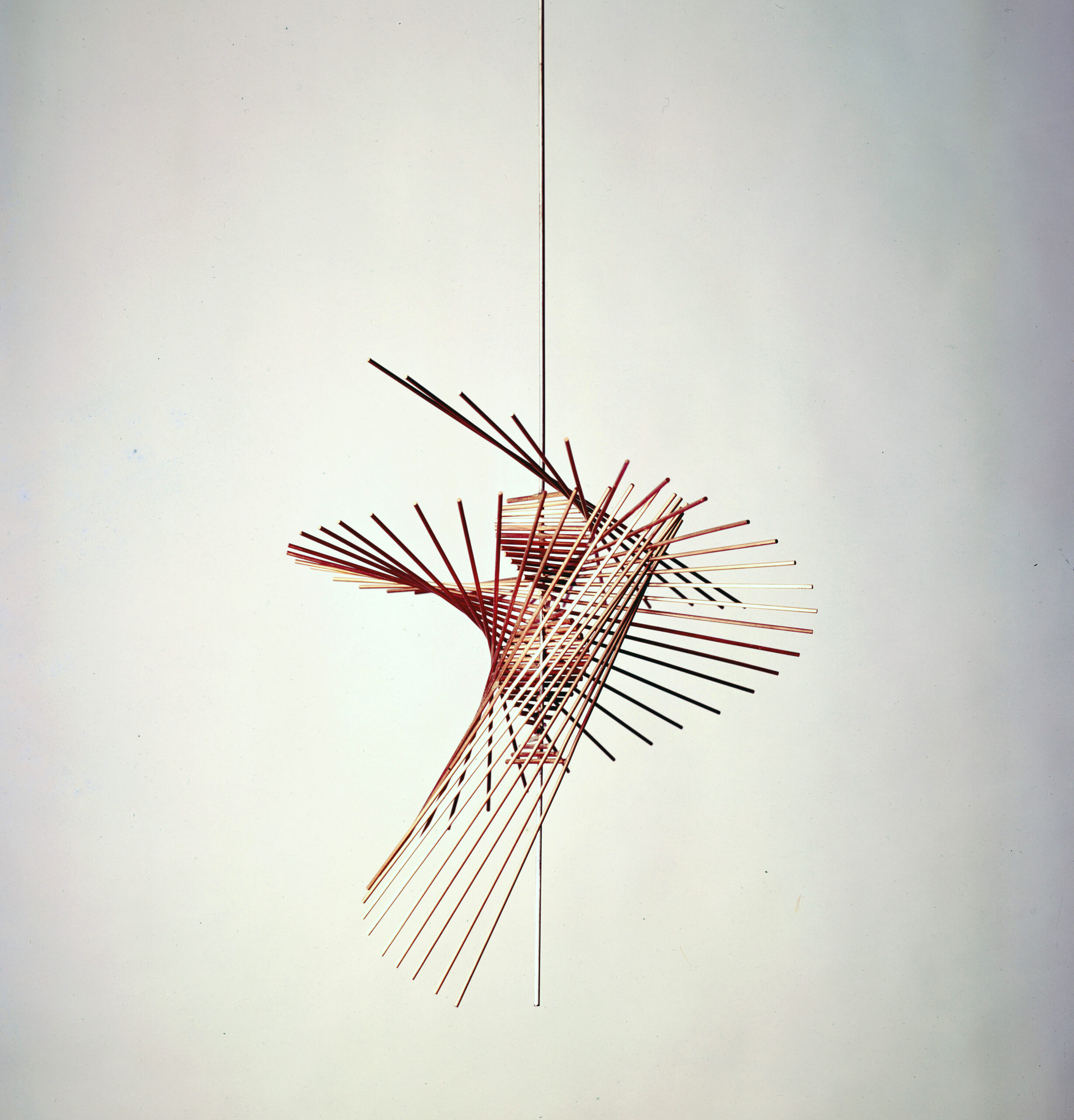
Photograph by Adrian Flowers
Between 1957 and 1975, Adrian Flowers made several visits to the studio of Mary and Kenneth Martin. Mary Martin, who died in 1969, pursued a distinguished career as a sculptor. Photographs of her by Flowers are featured in a previous post This is Tomorrow.
The present text deals mainly with Kenneth’s life and work. Taken with a Rolleiflex, using fine-grain black-and-white film, the early photographs taken by Flowers of Martin show him white-haired, looking more like a scientist than an artist, fabricating the abstract metal sculptures for which he had become well-known. Over the ensuing years, Flowers documented the development of Martin’s art. The last photographs, of a suspended brass spiral mobile, were taken in March 1975 with an 8 x10” Sinar camera, in preparation for a retrospective exhibition at the Tate Gallery, held that same year.

Kenneth Martin was part of a generation of artists whose careers were interrupted—and also partly defined—by WWII. After studying at the Sheffield School of Art, and working for six years as a designer in that city, in 1929 he was awarded a scholarship to the Royal College of Art. There he met Mary Balmford, a fellow student who had moved to the RCA from Goldsmith’s College. They were married the following year. Beginning in 1934, Martin exhibited with the Allied Artists’ Association, and two years later showed with the London Group, becoming a full member of the Group in 1949. He also worked as a designer in his early years in London. His first solo show was held at the Leicester Galleries in 1943. He taught at St. John’s Wood School of Art and was also a visiting lecturer at Goldsmiths.

Photographs by Adrian Flowers
Initially, Martin painted in the ‘Euston Road School’ style, but as the 1930’s advanced, he became more aware of progressive European and American art. In the late 1940’s, inspired by Victor Pasmore and Anthony Hill, he began to experiment with abstract forms, in a style reminiscent of Russian Constructivists such as Rodchenko, El Lissitzky and Tatlin. However, in post-war Britain the audience for avant-garde art—particularly an art that traced its roots back to revolutionary Russia—was limited. Claims that this art in Britain had sprung fully-formed from an interest in pure composition are unconvincing, although it is true that geometry and mathematics formed the essential language of Martin’s aesthetic. He described his constructions as resembling drawing in space with metal—an upbringing in the engineering town of Sheffield perhaps having a bearing on this conceptual approach. Made from lengths of metal welded together, often arranged around a vertical central spine, Martin’s sculptures were based on the idea of retaining and embodying the memory of a spiralling dynamic movement in space, akin to a propeller in water. The idea of rotation in abstract art, found also in the Synthetic Cubism of Albert Gleizes, was further enhanced in his spiral mobiles, where the sculpture was suspended, and allowed to rotate freely.

(JN 2803) Photograph by Adrian Flowers

(JN 2803) Photograph by Adrian Flowers
Although each pursued their own career, Kenneth and Mary Martin often worked closely together. In his introduction to the catalogue Mary Martin, Kenneth Martin, published to coincide with an Arts Council touring exhibition in 1970, Paul Overy described their approach: “In 1960 Mary Martin and Kenneth Martin made a Structure in Collaboration for a joint exhibition at the ICA, in Dover Street. It is a large work in four rectangular sections bolted together to form a large square, its scale and proportions directly related to the particular wall it was designed for, using the Fibonacci series in mathematics yet it does not give the impression of being coldly calculated. The whole structure is painted white and it seems perfect to combine the quiet, meditative introspection of Mary Martin’s earlier reliefs and the spiralling controlled energy of Kenneth Martin’s first series of mobiles.” The Martins worked on two such projects, the other being Environment, designed in collaboration with the architect John Weeks, for the ‘This is Tomorrow’ exhibition, held in 1956 at the Whitechapel Gallery. For this seminal show, the Martins made tall free-standing screens, again reminiscent of Russian Constructivist art, that embodied their theories on a modular, mathematically-based art, where accident and order were held in creative tension. Kenneth Martin’s creative method included using a limited range of materials, such as graph paper, square canvases and a restricted range of colours—and then he would, as it were, throw a dice, and introduce random factors into the composition. While he cited artists such as John Cage and Sol le Witt as having been influential in this regard, Martin’s art echoes the world of I Ching and the interaction of order and chance in the everyday world. Writing in 1987, Hilary Lane remarked “Kenneth Martin was interested in the opposition of experience and information and the puzzle of separating the two. He had a great capacity for experiencing the world; others have written of how the shortest journey in his company was made into a voyage of discovery. The physical sensations of moving through, over, under and across, of walking past, up and down were felt anew and tiny signs of nature, particularly as it triumphed in an urban habitat delighted him.” [Hilary Lane, University of Sussex, Introduction, Annely Juda Fine Art catalogue, 1987, p. 5] In a lecture given in 1956, Martin sought to outline the thinking behind his art:
The wise men of Lagado in Gulliver’s Travels carried on their backs objects to take the place of the spoken word. The construction, were it to act as a substitute for oil painting or drawing, would be as cumbersome and unnecessary. But the construction obeys its own laws and the dictates of its own material and expresses in a tangible manner what can only be expressed by that means. It is architectonic but not architecture and, in the case of the mobile, mechanistic, but in an aesthetic machine not a useful one. [‘Invention, a lecture 1956’, first published in Kenneth Martin, Tate Gallery, London 1975]
Working with assistant Susan Tebby, herself a noted Constructivist/Constructionist artist, Martin received several commissions for public sculptures, including, in 1960, a stainless steel kinetic work for a fountain at Lambeth College in Brixton, and Twin Screws for the Union of Architects building in London the following year. His 1967 Construction in Aluminium is sited at the entrance to the University of Cambridge’s Engineering Department, amidst Georgian terraces at Trumpington Street, Cambridge, while his construction for the Nuffield Institute at London Zoo dates from that same year. Four years later Martin was one of the artists shortlisted for a public art initiative sponsored by the Peter Stuyvesant Foundation and the Arts Council. Having been selected, in 1972 his Construction was installed at Arundel Gate in Sheffield, on a site now occupied by Sheffield Hallam University’s Owen Building. Based on the same mathematical system of rotations (“pendulum permutations”) employed by the artist in his smaller works, this six metre tall work consists of alternating plates and boxes, welded together to form a vertical column. The sculpture was fabricated locally, by Thomas Ward Ltd in Sheffield. Although it was hoped Construction would be purchased by the city’s Polytechnic, this did not transpire, and the work was shortly afterwards transferred to London, having been acquired by the Commonwealth Institute for its new building in Holland Park. It was later sited in parkland at Sutton Manor in Hampshire, and then at Millbank Street in Southampton, before being transferred to the New Art Centre in Wiltshire. In 2007 Construction was sold to a collector in California, but more recently it has returned to England. [Dr. Susan Tebby Kenneth Martin: Construction 1972 (New Art Centre 2022)

photograph: Peter Murray
The removal of Construction meant that there was no public sculpture by Martin in his home city of Sheffield, an omission that has not been rectified over the ensuing half century. Nor is there a sculpture by him in Sheffield Museum—although he is represented by a late abstract, Chance, Order, Change 24 History Painting A. (A portrait of Martin by Jeanne Masoero, a friend of Adrian Flowers, is also in Sheffield Museum). In 1987 a joint exhibition of Kenneth and Mary Martin’s work was held at Annely Juda Fine Art in Tottenham Mews London, followed by exhibitions at Kettle’s Yard, Cambridge and other institutions. Kenneth Martin is represented by several works in the Tate collection, in Bristol Museum and Art Gallery, and in other museums. In 2007-8, an exhibition of work by the Martins was held at Tate St Ives, and in 2022, on the fiftieth anniversary of its first siting, his Construction was sited again at the New Art Centre, at Roche Court in Wiltshire, with Susan Tebby contributing an essay to the catalogue published to mark the sculpture’s return.

Photograph taken by Adrian Flowers in 1975 for Tate Gallery exhibition in the same year
Text: Peter Murray
Editor: Francesca Flowers
All images subject to copyright
Adrian Flowers Archive ©